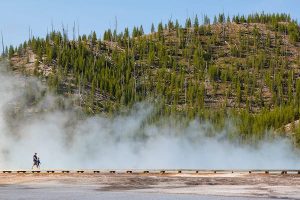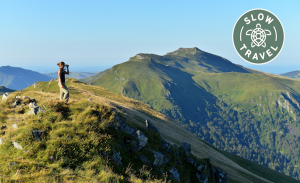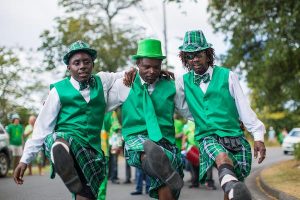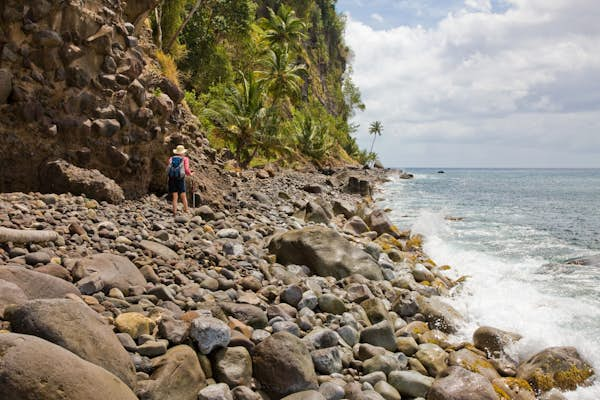
The Commonwealth of Dominica is a paradox. The island nation, which forms part of the Lesser Antilles in the Eastern Caribbean Sea, is an unhurried respite for those looking to disconnect from life’s chaos.
But the mountainous terrain of deep gorges, riotous verdant foliage, endless trails and bountiful rivers also make it an adventurer’s playground.
Don’t expect a large swath of sprawling luxury beach resorts and bone-white sand beaches. Dominica’s secret sauce lies in its untouched, raw qualities, earning the island its moniker “the nature isle.” To help you plan your getaway, here’s our guide to the best things to do in Dominica.
Explore the planet’s most surprising adventures with our weekly newsletter delivered to your inbox. 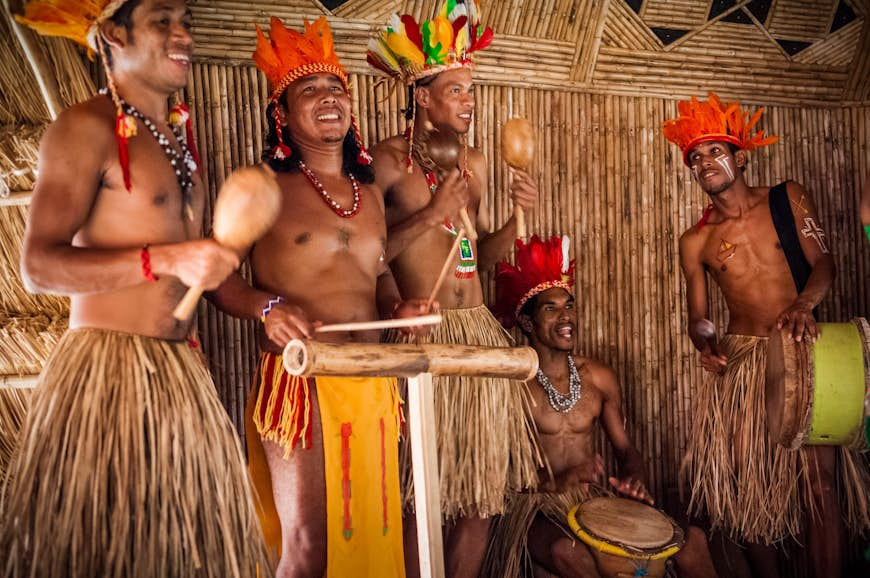 Musicians at Kalinago Barana Aute, a traditional village by the sea, sharing their culture © Alamy Stock Photo
Musicians at Kalinago Barana Aute, a traditional village by the sea, sharing their culture © Alamy Stock Photo
1. Immerse yourself in the Kalinago culture
The Kalinagos are the descendants of the pre-Columbus indigenous people of the Lesser Antilles who lived solely on what nature provided.
There are approximately 3000 Kalinagos who live on the 3,700 acres of communally held land reserved for the tribe on the eastern side of Dominica. The tribe is led by a six-member council and a chief.
Immerse yourself in the enduring history, rituals and customs of the island’s first inhabitants thanks to a collection of tours committed to creating authentic connections to the Kalinago culture.
These tours also generate income for members of the community. The experiences range from half-day excursions to home stays with a family on the reserve in traditional housing or ajoupas made from wood and leaves.
Local Tip: Try the roasted crayfish with coconut milk served on a warmed balisier (heliconia) leaf and sip on ouicou juice extracted from grated cassava.
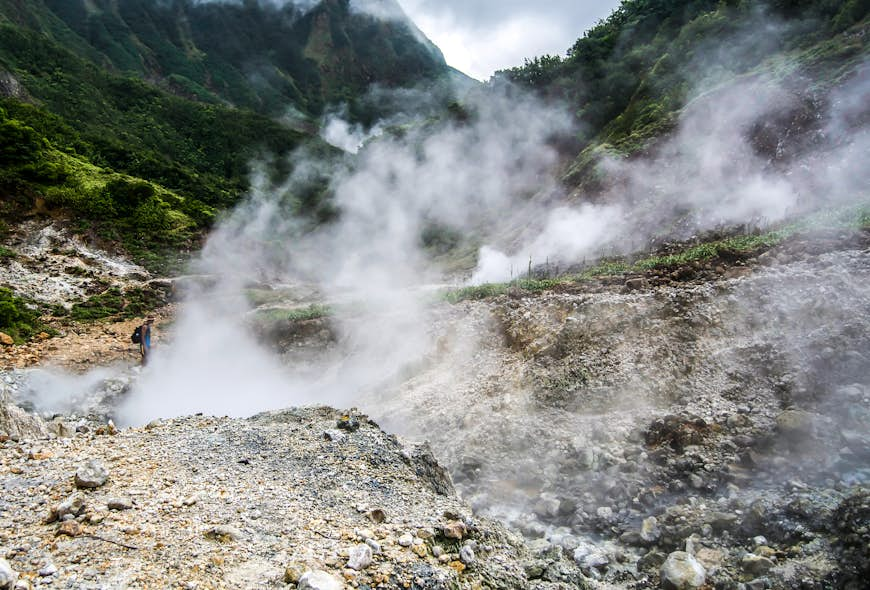 Hike to the world’s second-largest boiling lake in Dominica © Shutterstock / Joseph Thomas Photography
Hike to the world’s second-largest boiling lake in Dominica © Shutterstock / Joseph Thomas Photography
2. Visit Boiling Lake
Dominica’s Boiling Lake is a well-trodden landmark but worth the fanfare. The journey to the flooded fumarole starts in Laudat, a small village tucked away in the island’s interior.
Depending on your hiking skill level, it will take about two to four fours before you ultimately descend upon the world’s second-largest boiling lake (at 200ft wide).
The trail is deceptively manageable, but a guide is highly advised to help navigate the occasionally rocky and muddy terrain and paper-thin ridge.
The lake is a bubbling hot cauldron of slate grey liquid, shrouded in vapor. As is typical of any arduous, extended journey, you’ll be pleased to know that the return trip seems much quicker.
Planning Tip: Refill your water bottle at the Breakfast river, which is the only fresh water available after the hike begins.
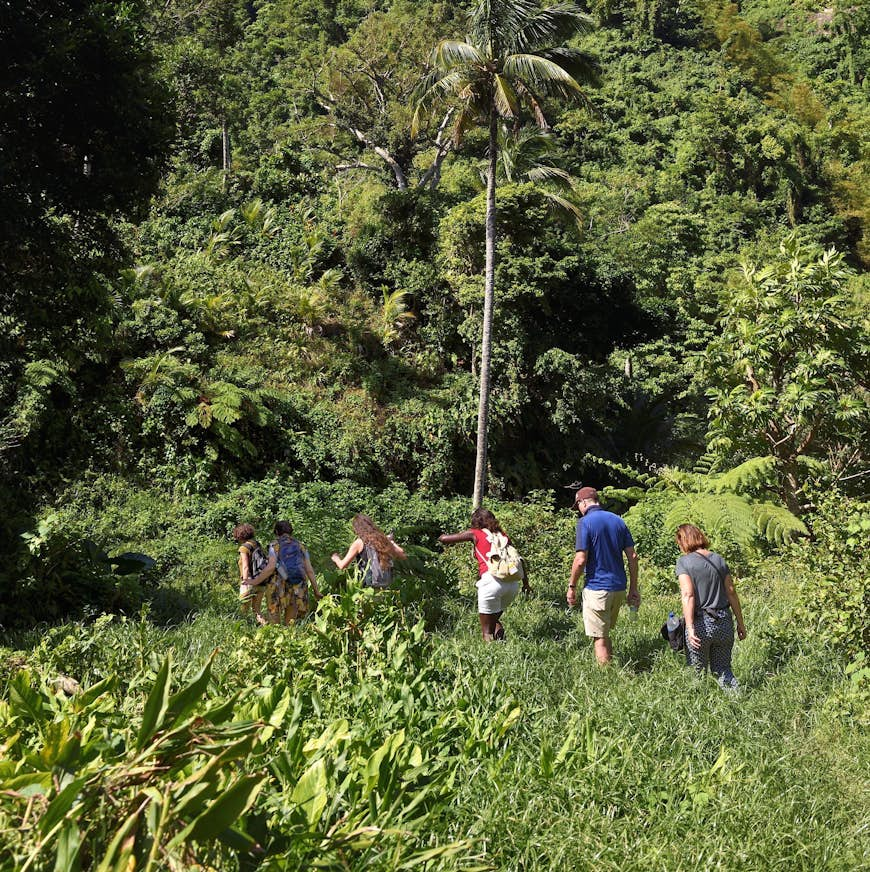 Walking segment 13 of the Waitukubuli National Trail between Pennville and Capuchin © Alamy Stock Photo
Walking segment 13 of the Waitukubuli National Trail between Pennville and Capuchin © Alamy Stock Photo
3. Hike parts of the Waitukubuli National Trail
Did you really visit Dominica if you didn’t hike a portion of the Waitukubuli National Trail (WNT)? The iconic trek is 114 miles, spanning the island’s length from the northernmost Scott’s Head and snaking through the dramatic mountainous landscape and dense rainforest to Cabrits National Park.
WNT is the only long-distance hiking trail in the Caribbean. Each of the trail’s 14 segments presents its unique challenges so if you’re not up for the entire route, pick one or more sections to explore.
The difficulty level of the trail’s segments varies from easy, family-friendly fun to a more strenuous expedition. Hiking the trail is a serious time commitment — the entire route takes two weeks to complete.
But it’s the ultimate scenic excursion, meandering through waterfalls, rivers, Kalinago villages, Maroon passages and multiple other historical and natural sites.
It’s always best to hire a guide or join a hiking group.
Planning Tip: With 365 rivers woven throughout the island, running into one during a hike is inevitable. Proceed cautiously — you may encounter slippery rocks or flash flooding from heavy rainfall.
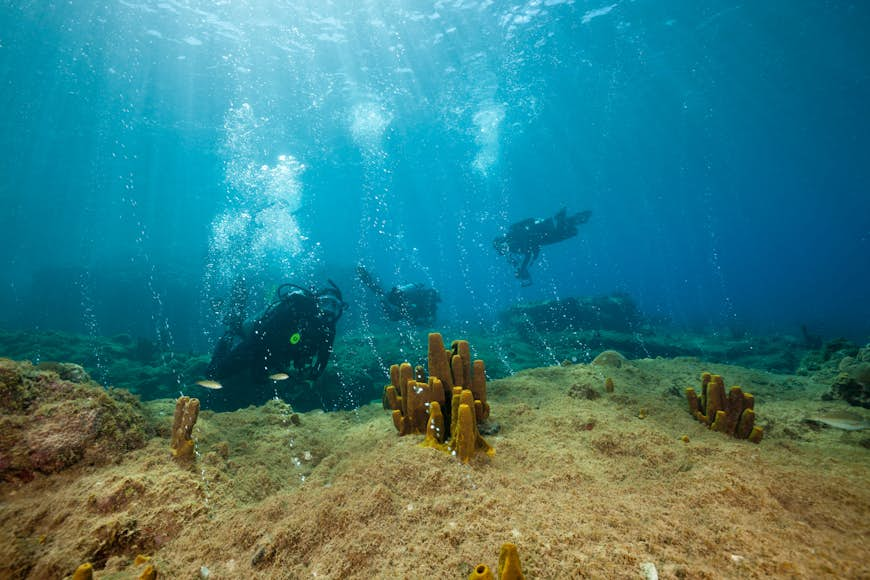 Go diving or snorkeling on Champagne Reef © Alamy Stock Photo
Go diving or snorkeling on Champagne Reef © Alamy Stock Photo
4. Dive into the effervescent Champagne Reef
Diving into Champagne Reef mirrors the sensation of swimming in an oversized glass of the bubbly drink thanks to the volcanic gas bubbling up from the seabed. The golden hue of the actual reef completes the illusion.
Snorkeling enthusiasts will also be enamored with the burst of color reflecting from the horde of sea creatures — including trumpet fish, parrotfish, frogfish, octopus, rays, batfish, hawksbill turtles and seahorses.
The vibrance of the pink azure, red rope, yellow tube, and purple vase sponges adds to the kaleidoscopic effect.
Planning Tip: Large pebbles dot the Champagne Reef beachfront, so don’t expect to lay out on the sand. But do enjoy the local rums, Dominican cuisine and intel on the best snorkeling spots at Donny’s Beach Bar.
 Get in the plunge pools at Trafalgar Falls in Morne Trois Pitons National Park © Alamy Stock Photo
Get in the plunge pools at Trafalgar Falls in Morne Trois Pitons National Park © Alamy Stock Photo
5. Spend a day at Trafalgar Falls
Dominica’s twin falls are a mere 20-minute drive from the capital Roseau, to the west of the Morne Trois Pitons National Park.
A brief 10 to 15-minute walk through the rainforest leads to a viewing platform where you can embrace the majesty of the falls. Locally known as “Papa” (to the left) and “Mama” (to the right); each has its distinct features.
Papa towers over the surroundings at 125ft while Mama is a diminutive 75ft but with a more forceful gush of water. Consider a dip in the warm pools at the base of the falls.
A guide is necessary if you intend to hike the falls. Be extremely careful because slippery boulders can make for a treacherous and challenging climb. Head out as early as possible for optimal lighting.
Local Tip: Wildlife and rare plant lovers should consider a pit stop at Papillote Tropical Gardens, just before the trailhead.
6. Lounge on Pointe Baptiste beach
Much has been made of Dominica’s tour de force of 365 rivers. But for an aquatic getaway, Pointe Baptiste beach is a worthy contender. Drive to the village of Calibishie on the island’s northeast coast to this secluded haven that offers an opportunity to unwind in peace.
The water is shallow, warm and tranquil, which makes it ideal for kids. However, couples still have enough privacy thanks to the surrounding stones and Red Rocks. This natural auburn rock formation hugs the northeastern coastline and overlooks the Atlantic Ocean.
Local Tip: Explore the sweeter side of Dominica at the nearby Pointe Baptiste Estate Chocolate Factory. The small family operation takes visitors through a tour of the process that transforms cacao beans into flavorful chocolate bars.
 Spot the filming locations at Emerald Pool on the nature isle of Dominica © radek6 / Getty Images
Spot the filming locations at Emerald Pool on the nature isle of Dominica © radek6 / Getty Images
7. Experience the Emerald Pool
Dominica is carpeted in shades of green, from the dense forests to the luminescent and appropriately named Emerald Pool. A gush of fresh water from a 40ft waterfall feeds the ethereal grotto. Its greenish tint reflects the foliage, vines and moss-covered rocks that envelop the area, allowing sunlight to filter through.
The road to Emerald Pool starts in Pont Cassé, a small centrally located village and continues inside the Morne Trois Piton National Park. It’s easily accessible.
Hop a local minibus and let the driver know where you’re going. There’s also plenty of parking if you decide to drive yourself.
Two viewing platforms provide a magical vantage point, but if you prefer to swim, bathrooms and changing rooms are also available at the visitors center. You might recognize the oasis as one of the stunning backdrops in the Pirates of the Caribbean franchise.
The water is chilly, even on the hottest days. The water is also not very deep, so don’t jump off the higher rocks or dive in.
Local Tip: Venture about 15 minutes away to nearby Castle Bruce and enjoy a sumptuous meal and drinks from the Islet View Restaurant & Bar overlooking the bay.
8. Explore the streets of Roseau
Roseau is a small, compact southwestern city surrounded by Morne Bruce, the Caribbean Sea, and the Roseau River. Get to know the quaint capital with a walking tour of the significant sites.
Start with the Old Market, which was once a bustling trading post in colonial times. Now it has been reimagined into a craft hub where vendors ply handmade soaps, oils, accessories and fragrant spices. The Dominica Museum shares the seafront, with historical and cultural artifacts curated by the island’s foremost historian Lennox Honychurch.
The once thriving Dominica Botanical Gardens suffered extensive damage at the hands of Hurricane David in 1979 but still boasts 40 acres featuring 50 types of plant life. Make the hike up Morne Bruce to soak in the stunning panoramic views of the city and cool down later at one of the local haunts with the hometown beer Kubuli.
Planning Tip: Consider purchasing a budget-friendly special tourist site pass. A weeklong pass with multiple visits to all sites within the national park system and several other nature landmarks costs USD$12.

